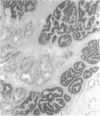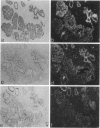Abstract
The expression of cytokeratin (CK) mRNA for CK5, -8, -14, -16, and -19 was investigated in normal prostate, prostatic intraepithelial neoplasia (PIN) lesions, and invasive carcinoma using in situ hybridization. Protein localization was carried out in adjacent sections using immunohistochemistry and correlated with mRNA expression. Snap-frozen human prostate samples including 22 examples of normal glands, 20 cases of PIN lesions, and 12 cases of invasive carcinoma were examined. CK5 and -14 mRNA and protein were prominently expressed only in the basal cells of normal glands and PIN lesions. CK14 mRNA was absent in the luminal cells of the most of the PIN lesions but was seen at a low level in some PIN lesions. CK14 protein was not detected in any PIN lesion, suggesting that, if the cell that makes up the PIN lesions is derived from a basal cell, CK14 translation is depressed although a low level of CK14 mRNA may persist. CK8 mRNA and protein were constitutively expressed in all epithelia of normal and abnormal prostate tissues. CK19 mRNA and protein were persistently expressed in both basal and luminal cells of the tubular portion of normal glands as well as PIN lesions, but were expressed heterogeneously in both basal and luminal cells of normal alveoli. CK16 mRNA was expressed in a similar pattern as CK19, but CK16 protein was not detected either in normal or in abnormal prostate tissues. In conclusion, the expression of CK19 in PIN lesions is similar to its tubular expression and would support an origin of PIN lesions from this structure rather than the alveolar portion of the glands. The similar cytokeratin expression between PIN lesions and invasive carcinoma further supports the concept that PIN is a precursor lesion of invasive carcinoma.
Full text
PDF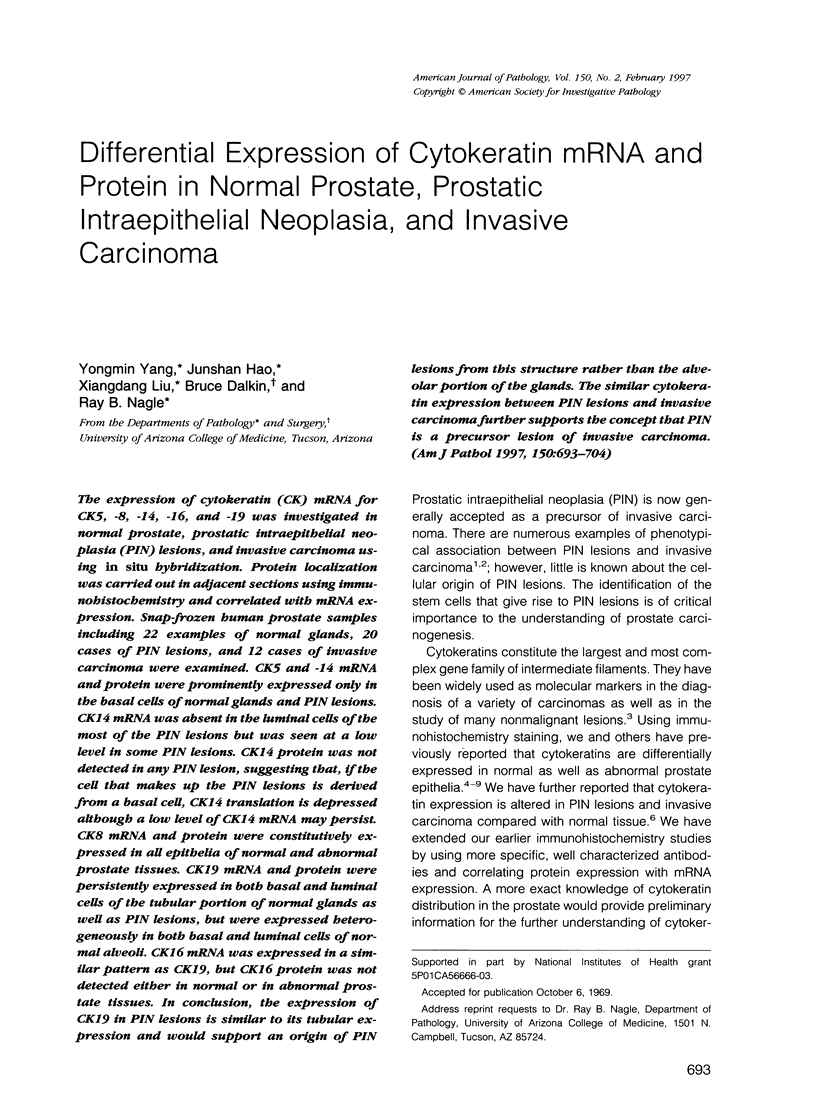
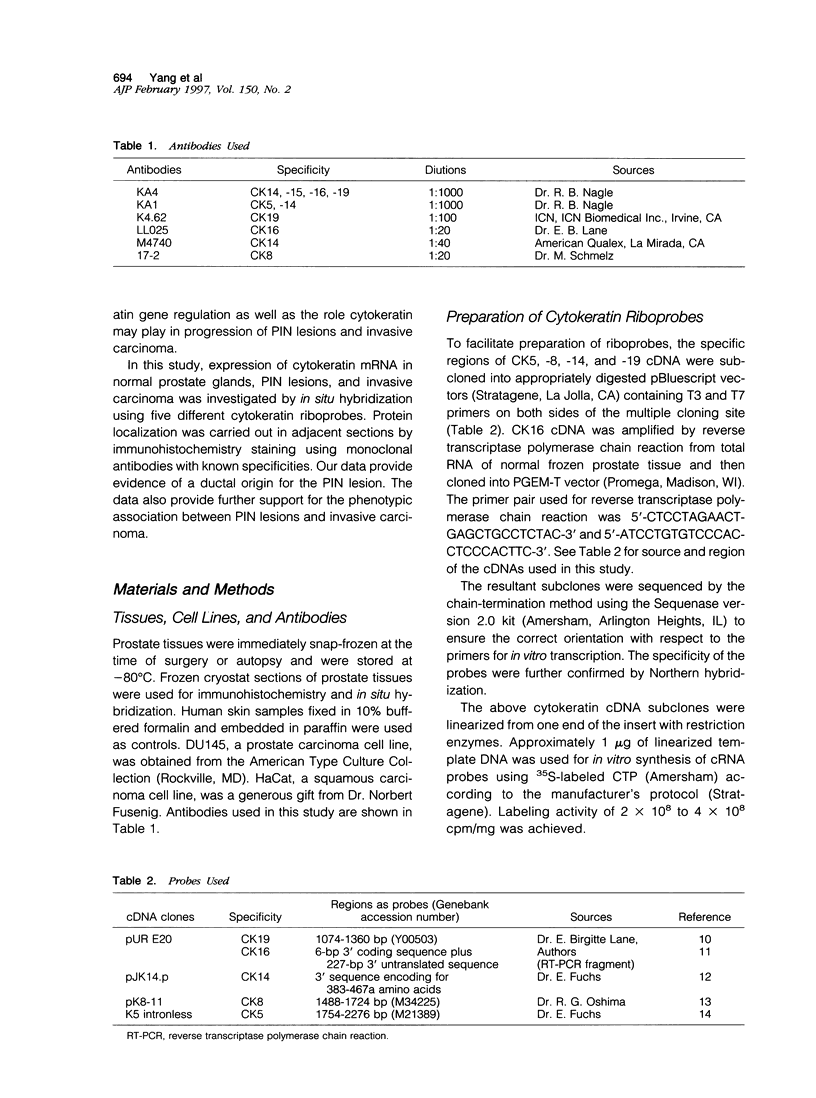
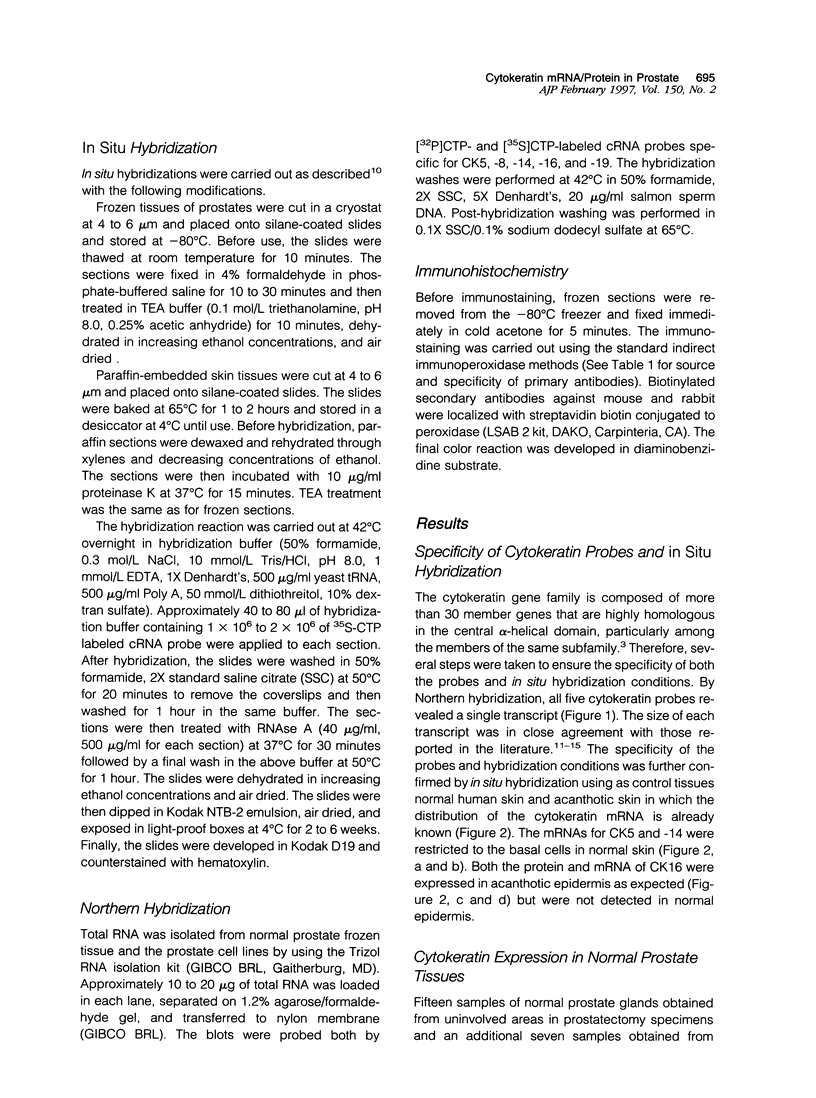
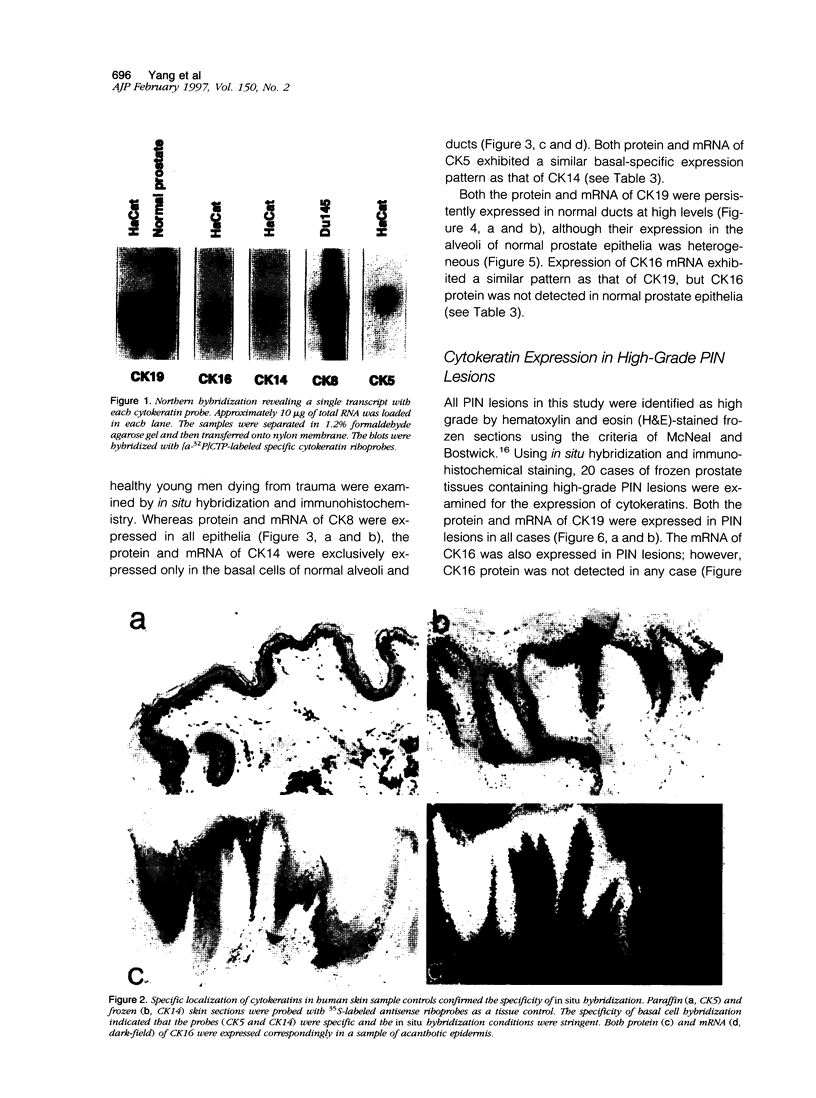
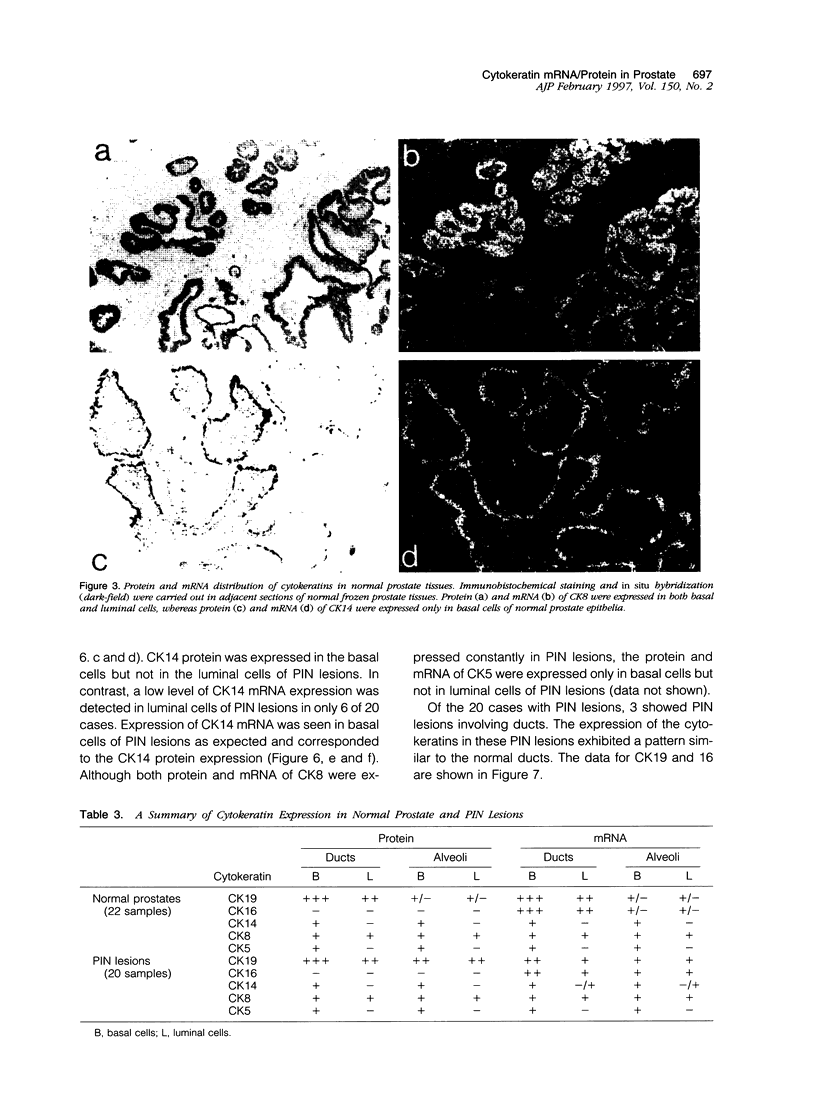
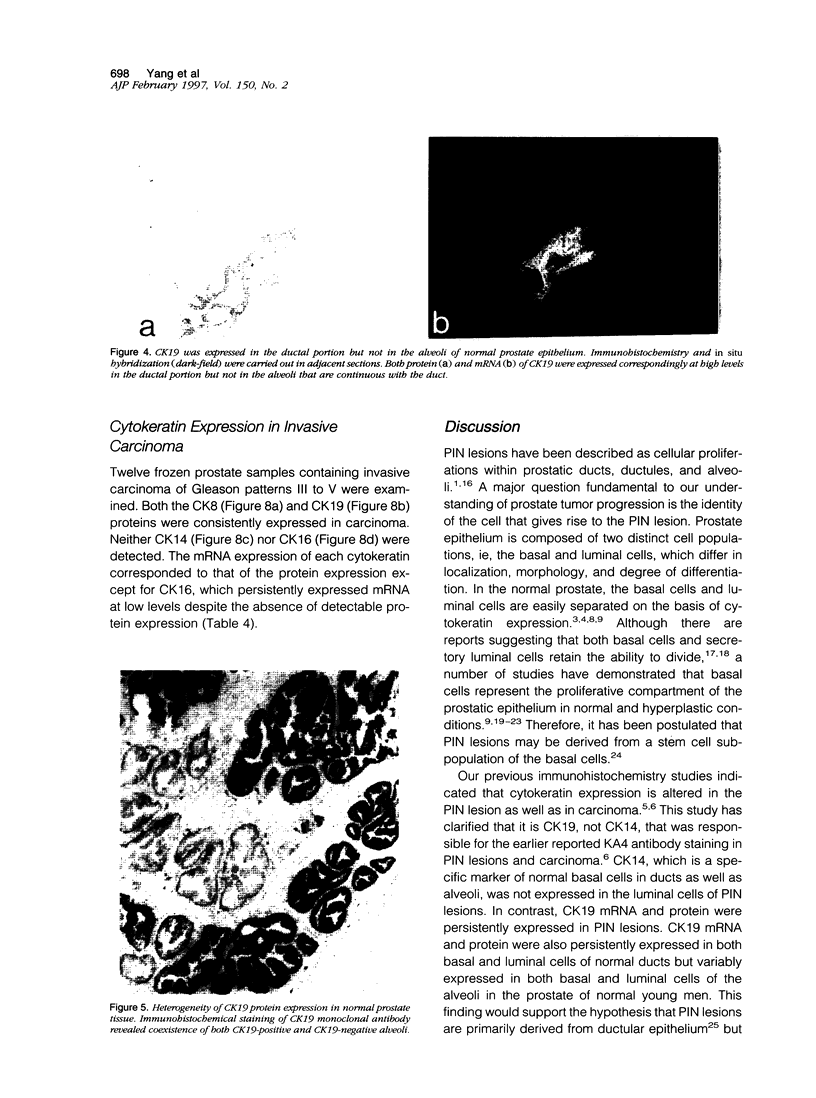
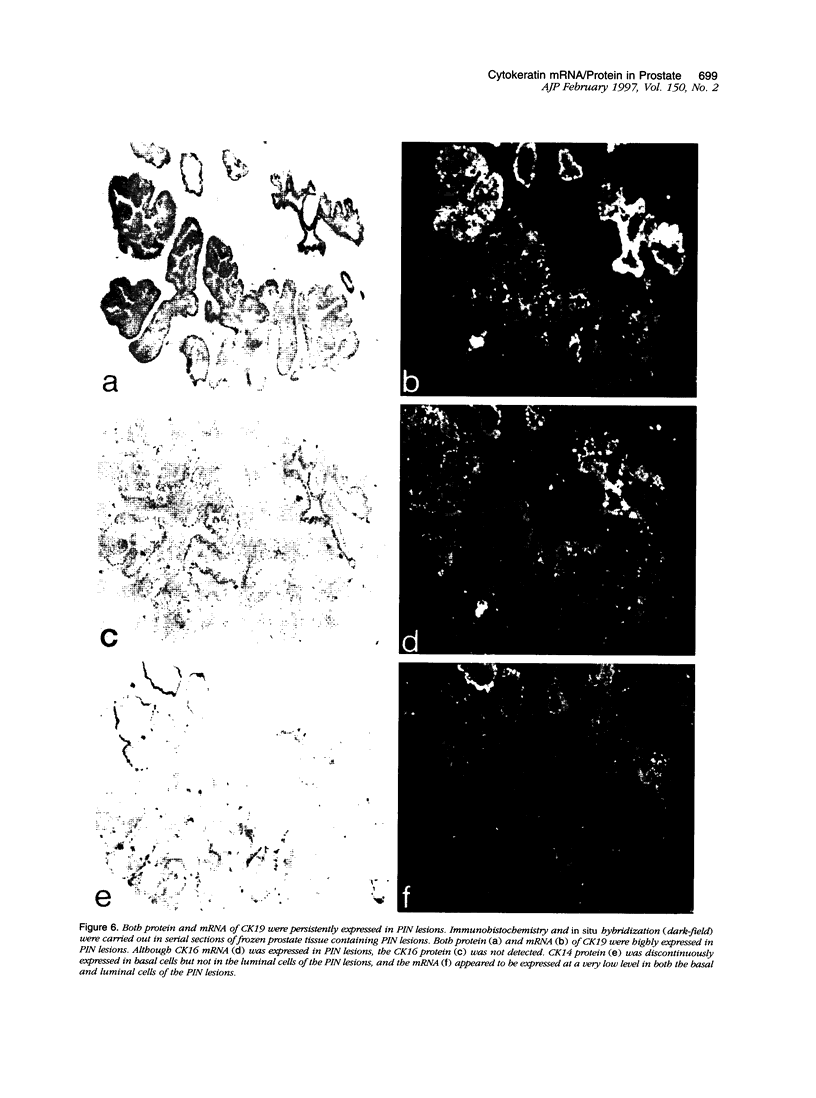
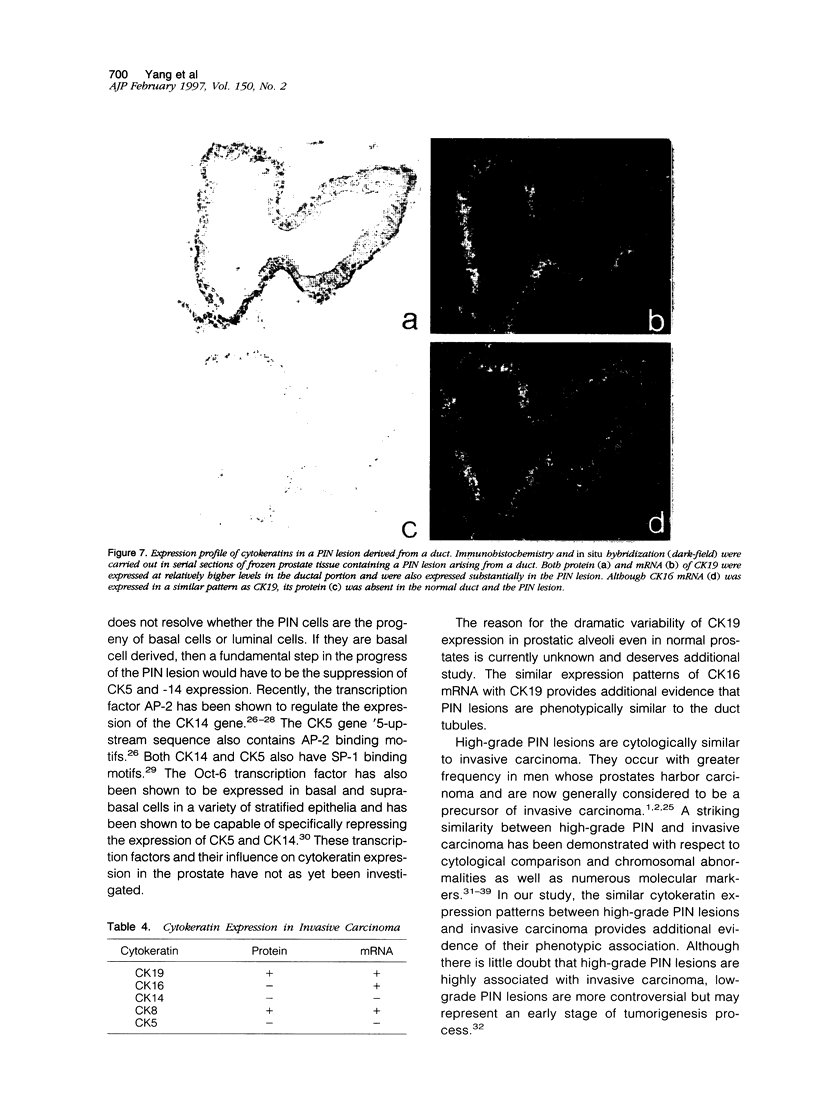
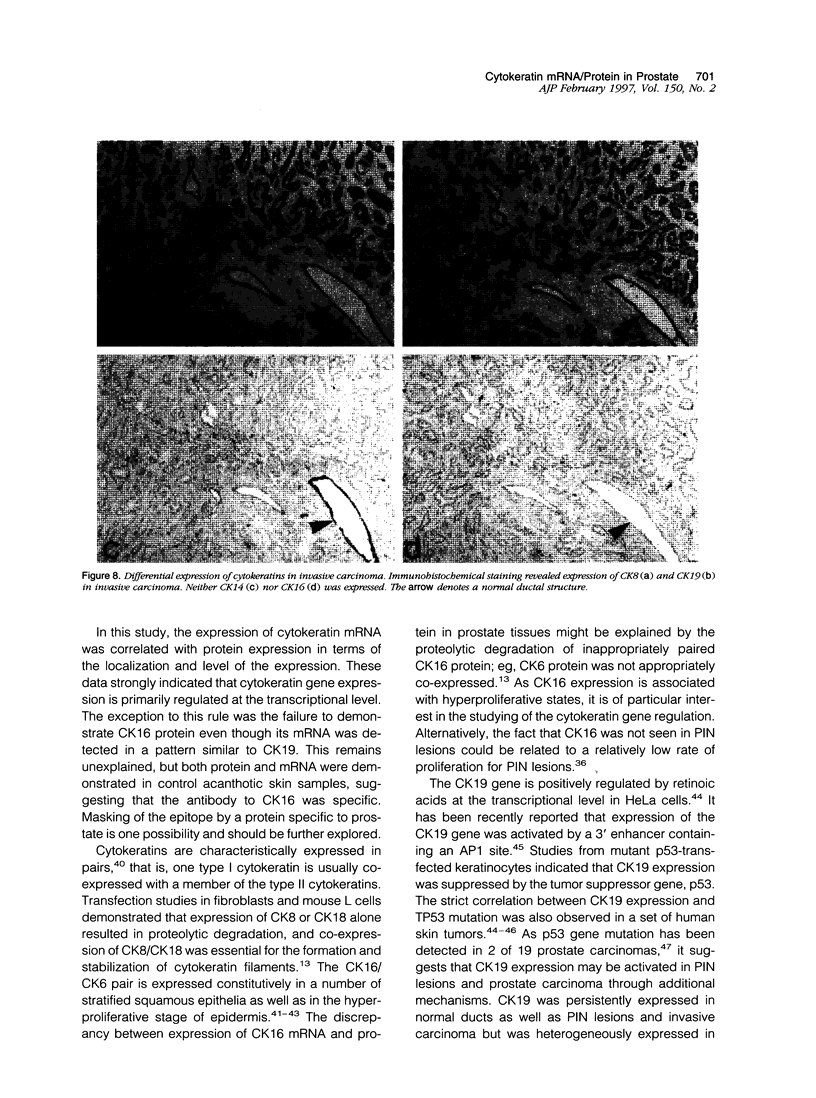
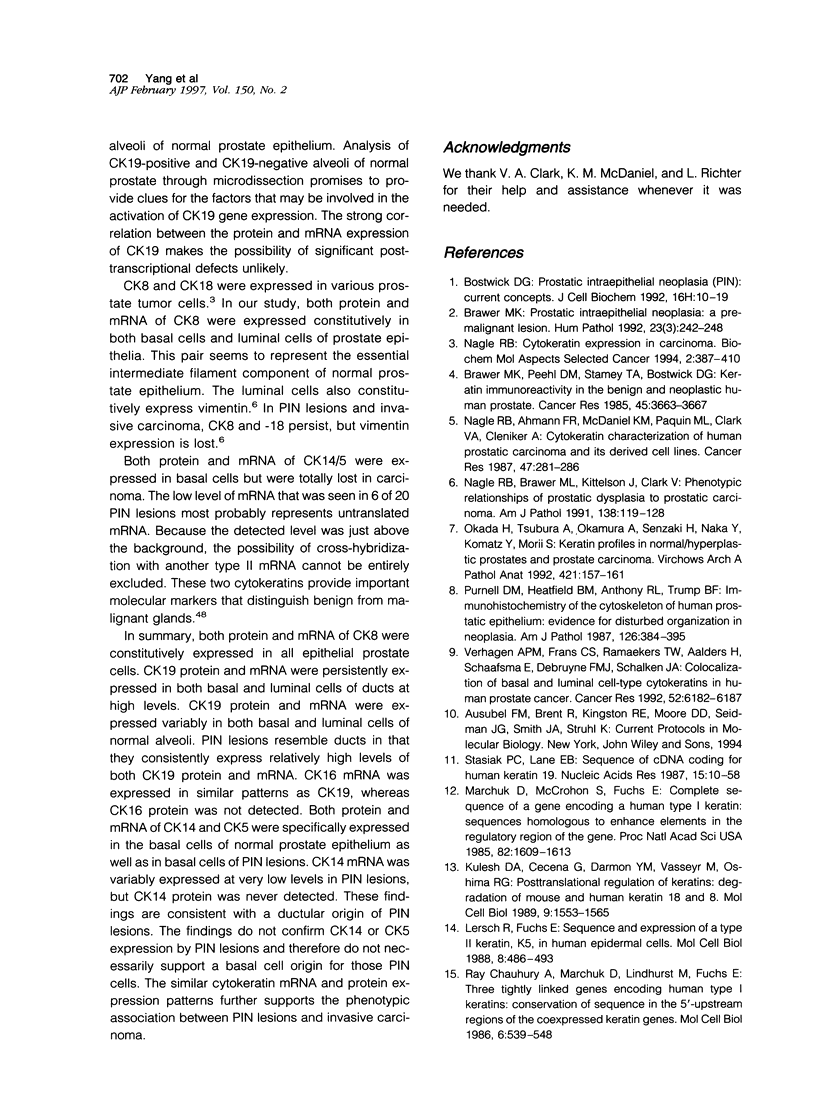
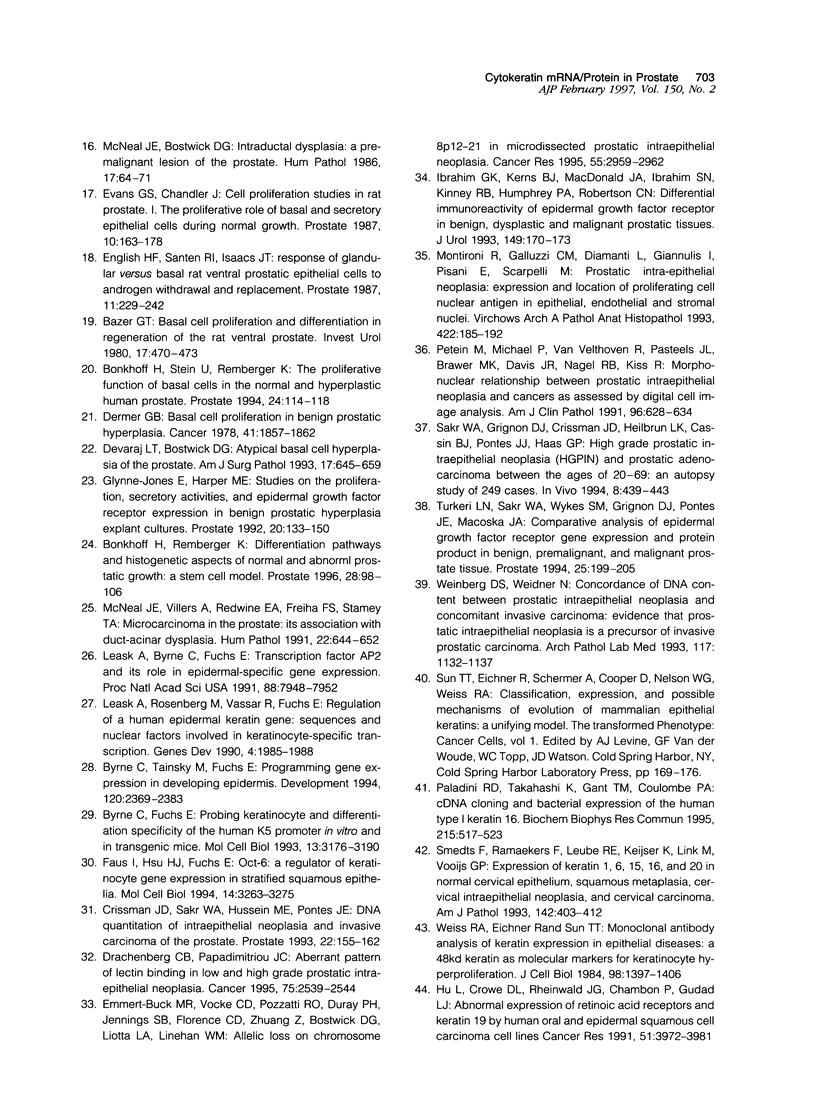

Images in this article
Selected References
These references are in PubMed. This may not be the complete list of references from this article.
- Bazer G. T. Basal cell proliferation and differentiation in regeneration of the rat ventral prostate. Invest Urol. 1980 May;17(6):470–473. [PubMed] [Google Scholar]
- Bonkhoff H., Remberger K. Differentiation pathways and histogenetic aspects of normal and abnormal prostatic growth: a stem cell model. Prostate. 1996 Feb;28(2):98–106. doi: 10.1002/(SICI)1097-0045(199602)28:2<98::AID-PROS4>3.0.CO;2-J. [DOI] [PubMed] [Google Scholar]
- Bonkhoff H., Stein U., Remberger K. The proliferative function of basal cells in the normal and hyperplastic human prostate. Prostate. 1994;24(3):114–118. doi: 10.1002/pros.2990240303. [DOI] [PubMed] [Google Scholar]
- Bostwick D. G. Prostatic intraepithelial neoplasia (PIN): current concepts. J Cell Biochem Suppl. 1992;16H:10–19. doi: 10.1002/jcb.240501205. [DOI] [PubMed] [Google Scholar]
- Brawer M. K., Peehl D. M., Stamey T. A., Bostwick D. G. Keratin immunoreactivity in the benign and neoplastic human prostate. Cancer Res. 1985 Aug;45(8):3663–3667. [PubMed] [Google Scholar]
- Brawer M. K. Prostatic intraepithelial neoplasia: a premalignant lesion. Hum Pathol. 1992 Mar;23(3):242–248. doi: 10.1016/0046-8177(92)90104-b. [DOI] [PubMed] [Google Scholar]
- Byrne C., Fuchs E. Probing keratinocyte and differentiation specificity of the human K5 promoter in vitro and in transgenic mice. Mol Cell Biol. 1993 Jun;13(6):3176–3190. doi: 10.1128/mcb.13.6.3176. [DOI] [PMC free article] [PubMed] [Google Scholar]
- Byrne C., Tainsky M., Fuchs E. Programming gene expression in developing epidermis. Development. 1994 Sep;120(9):2369–2383. doi: 10.1242/dev.120.9.2369. [DOI] [PubMed] [Google Scholar]
- Crissman J. D., Sakr W. A., Hussein M. E., Pontes J. E. DNA quantitation of intraepithelial neoplasia and invasive carcinoma of the prostate. Prostate. 1993;22(2):155–162. doi: 10.1002/pros.2990220208. [DOI] [PubMed] [Google Scholar]
- Dermer G. B. Basal cell proliferation in benign prostatic hyperplasia. Cancer. 1978 May;41(5):1857–1862. doi: 10.1002/1097-0142(197805)41:5<1857::aid-cncr2820410529>3.0.co;2-t. [DOI] [PubMed] [Google Scholar]
- Devaraj L. T., Bostwick D. G. Atypical basal cell hyperplasia of the prostate. Immunophenotypic profile and proposed classification of basal cell proliferations. Am J Surg Pathol. 1993 Jul;17(7):645–659. doi: 10.1097/00000478-199307000-00001. [DOI] [PubMed] [Google Scholar]
- Drachenberg C. B., Papadimitriou J. C. Aberrant pattern of lectin binding in low and high grade prostatic intraepithelial neoplasia. Cancer. 1995 May 15;75(10):2539–2544. doi: 10.1002/1097-0142(19950515)75:10<2539::aid-cncr2820751021>3.0.co;2-p. [DOI] [PubMed] [Google Scholar]
- Emmert-Buck M. R., Vocke C. D., Pozzatti R. O., Duray P. H., Jennings S. B., Florence C. D., Zhuang Z., Bostwick D. G., Liotta L. A., Linehan W. M. Allelic loss on chromosome 8p12-21 in microdissected prostatic intraepithelial neoplasia. Cancer Res. 1995 Jul 15;55(14):2959–2962. [PubMed] [Google Scholar]
- English H. F., Santen R. J., Isaacs J. T. Response of glandular versus basal rat ventral prostatic epithelial cells to androgen withdrawal and replacement. Prostate. 1987;11(3):229–242. doi: 10.1002/pros.2990110304. [DOI] [PubMed] [Google Scholar]
- Evans G. S., Chandler J. A. Cell proliferation studies in rat prostate. I. The proliferative role of basal and secretory epithelial cells during normal growth. Prostate. 1987;10(2):163–178. doi: 10.1002/pros.2990100208. [DOI] [PubMed] [Google Scholar]
- Faus I., Hsu H. J., Fuchs E. Oct-6: a regulator of keratinocyte gene expression in stratified squamous epithelia. Mol Cell Biol. 1994 May;14(5):3263–3275. doi: 10.1128/mcb.14.5.3263. [DOI] [PMC free article] [PubMed] [Google Scholar]
- Hu L., Crowe D. L., Rheinwald J. G., Chambon P., Gudas L. J. Abnormal expression of retinoic acid receptors and keratin 19 by human oral and epidermal squamous cell carcinoma cell lines. Cancer Res. 1991 Aug 1;51(15):3972–3981. [PubMed] [Google Scholar]
- Hu L., Gudas L. J. Activation of keratin 19 gene expression by a 3' enhancer containing an AP1 site. J Biol Chem. 1994 Jan 7;269(1):183–191. [PubMed] [Google Scholar]
- Ibrahim G. K., Kerns B. J., MacDonald J. A., Ibrahim S. N., Kinney R. B., Humphrey P. A., Robertson C. N. Differential immunoreactivity of epidermal growth factor receptor in benign, dysplastic and malignant prostatic tissues. J Urol. 1993 Jan;149(1):170–173. doi: 10.1016/s0022-5347(17)36032-9. [DOI] [PubMed] [Google Scholar]
- Jones E. G., Harper M. E. Studies on the proliferation, secretory activities, and epidermal growth factor receptor expression in benign prostatic hyperplasia explant cultures. Prostate. 1992;20(2):133–149. doi: 10.1002/pros.2990200209. [DOI] [PubMed] [Google Scholar]
- Kulesh D. A., Ceceña G., Darmon Y. M., Vasseur M., Oshima R. G. Posttranslational regulation of keratins: degradation of mouse and human keratins 18 and 8. Mol Cell Biol. 1989 Apr;9(4):1553–1565. doi: 10.1128/mcb.9.4.1553. [DOI] [PMC free article] [PubMed] [Google Scholar]
- Leask A., Byrne C., Fuchs E. Transcription factor AP2 and its role in epidermal-specific gene expression. Proc Natl Acad Sci U S A. 1991 Sep 15;88(18):7948–7952. doi: 10.1073/pnas.88.18.7948. [DOI] [PMC free article] [PubMed] [Google Scholar]
- Leask A., Rosenberg M., Vassar R., Fuchs E. Regulation of a human epidermal keratin gene: sequences and nuclear factors involved in keratinocyte-specific transcription. Genes Dev. 1990 Nov;4(11):1985–1998. doi: 10.1101/gad.4.11.1985. [DOI] [PubMed] [Google Scholar]
- Lersch R., Fuchs E. Sequence and expression of a type II keratin, K5, in human epidermal cells. Mol Cell Biol. 1988 Jan;8(1):486–493. doi: 10.1128/mcb.8.1.486. [DOI] [PMC free article] [PubMed] [Google Scholar]
- Marchuk D., McCrohon S., Fuchs E. Complete sequence of a gene encoding a human type I keratin: sequences homologous to enhancer elements in the regulatory region of the gene. Proc Natl Acad Sci U S A. 1985 Mar;82(6):1609–1613. doi: 10.1073/pnas.82.6.1609. [DOI] [PMC free article] [PubMed] [Google Scholar]
- McNeal J. E., Bostwick D. G. Intraductal dysplasia: a premalignant lesion of the prostate. Hum Pathol. 1986 Jan;17(1):64–71. doi: 10.1016/s0046-8177(86)80156-3. [DOI] [PubMed] [Google Scholar]
- McNeal J. E., Villers A., Redwine E. A., Freiha F. S., Stamey T. A. Microcarcinoma in the prostate: its association with duct-acinar dysplasia. Hum Pathol. 1991 Jul;22(7):644–652. doi: 10.1016/0046-8177(91)90286-x. [DOI] [PubMed] [Google Scholar]
- Molès J. P., Schiller J. T., Tesniere A., Leigh I. M., Guilhou J. J., Basset-Séguin N. Analysis of HPV16 E6 and mutant p53-transfected keratinocytes in reconstituted epidermis suggests that wild-type p53 inhibits cytokeratin 19 expression. J Cell Sci. 1994 Feb;107(Pt 2):435–441. doi: 10.1242/jcs.107.2.435. [DOI] [PubMed] [Google Scholar]
- Montironi R., Galluzzi C. M., Diamanti L., Giannulis I., Pisani E., Scarpelli M. Prostatic intra-epithelial neoplasia: expression and location of proliferating cell nuclear antigen in epithelial, endothelial and stromal nuclei. Virchows Arch A Pathol Anat Histopathol. 1993;422(3):185–192. doi: 10.1007/BF01621801. [DOI] [PubMed] [Google Scholar]
- Moyret-Lalle C., Marçais C., Jacquemier J., Moles J. P., Daver A., Soret J. Y., Jeanteur P., Ozturk M., Theillet C. ras, p53 and HPV status in benign and malignant prostate tumors. Int J Cancer. 1995 Apr 21;64(2):124–129. doi: 10.1002/ijc.2910640209. [DOI] [PubMed] [Google Scholar]
- Nagle R. B., Ahmann F. R., McDaniel K. M., Paquin M. L., Clark V. A., Celniker A. Cytokeratin characterization of human prostatic carcinoma and its derived cell lines. Cancer Res. 1987 Jan 1;47(1):281–286. [PubMed] [Google Scholar]
- Nagle R. B., Brawer M. K., Kittelson J., Clark V. Phenotypic relationships of prostatic intraepithelial neoplasia to invasive prostatic carcinoma. Am J Pathol. 1991 Jan;138(1):119–128. [PMC free article] [PubMed] [Google Scholar]
- Okada H., Tsubura A., Okamura A., Senzaki H., Naka Y., Komatz Y., Morii S. Keratin profiles in normal/hyperplastic prostates and prostate carcinoma. Virchows Arch A Pathol Anat Histopathol. 1992;421(2):157–161. doi: 10.1007/BF01607049. [DOI] [PubMed] [Google Scholar]
- Paladini R. D., Takahashi K., Gant T. M., Coulombe P. A. cDNA cloning and bacterial expression of the human type I keratin 16. Biochem Biophys Res Commun. 1995 Oct 13;215(2):517–523. doi: 10.1006/bbrc.1995.2495. [DOI] [PubMed] [Google Scholar]
- Petein M., Michel P., van Velthoven R., Pasteels J. L., Brawer M. K., Davis J. R., Nagle R. B., Kiss R. Morphonuclear relationship between prostatic intraepithelial neoplasia and cancers as assessed by digital cell image analysis. Am J Clin Pathol. 1991 Nov;96(5):628–634. doi: 10.1093/ajcp/96.5.628. [DOI] [PubMed] [Google Scholar]
- Purnell D. M., Heatfield B. M., Anthony R. L., Trump B. F. Immunohistochemistry of the cytoskeleton of human prostatic epithelium. Evidence for disturbed organization in neoplasia. Am J Pathol. 1987 Feb;126(2):384–395. [PMC free article] [PubMed] [Google Scholar]
- RayChaudhury A., Marchuk D., Lindhurst M., Fuchs E. Three tightly linked genes encoding human type I keratins: conservation of sequence in the 5'-untranslated leader and 5'-upstream regions of coexpressed keratin genes. Mol Cell Biol. 1986 Feb;6(2):539–548. doi: 10.1128/mcb.6.2.539. [DOI] [PMC free article] [PubMed] [Google Scholar]
- Sakr W. A., Grignon D. J., Crissman J. D., Heilbrun L. K., Cassin B. J., Pontes J. J., Haas G. P. High grade prostatic intraepithelial neoplasia (HGPIN) and prostatic adenocarcinoma between the ages of 20-69: an autopsy study of 249 cases. In Vivo. 1994 May-Jun;8(3):439–443. [PubMed] [Google Scholar]
- Smedts F., Ramaekers F., Leube R. E., Keijser K., Link M., Vooijs P. Expression of keratins 1, 6, 15, 16, and 20 in normal cervical epithelium, squamous metaplasia, cervical intraepithelial neoplasia, and cervical carcinoma. Am J Pathol. 1993 Feb;142(2):403–412. [PMC free article] [PubMed] [Google Scholar]
- Turkeri L. N., Sakr W. A., Wykes S. M., Grignon D. J., Pontes J. E., Macoska J. A. Comparative analysis of epidermal growth factor receptor gene expression and protein product in benign, premalignant, and malignant prostate tissue. Prostate. 1994 Oct;25(4):199–205. doi: 10.1002/pros.2990250405. [DOI] [PubMed] [Google Scholar]
- Verhagen A. P., Ramaekers F. C., Aalders T. W., Schaafsma H. E., Debruyne F. M., Schalken J. A. Colocalization of basal and luminal cell-type cytokeratins in human prostate cancer. Cancer Res. 1992 Nov 15;52(22):6182–6187. [PubMed] [Google Scholar]
- Weinberg D. S., Weidner N. Concordance of DNA content between prostatic intraepithelial neoplasia and concomitant invasive carcinoma. Evidence that prostatic intraepithelial neoplasia is a precursor of invasive prostatic carcinoma. Arch Pathol Lab Med. 1993 Nov;117(11):1132–1137. [PubMed] [Google Scholar]
- Weiss R. A., Eichner R., Sun T. T. Monoclonal antibody analysis of keratin expression in epidermal diseases: a 48- and 56-kdalton keratin as molecular markers for hyperproliferative keratinocytes. J Cell Biol. 1984 Apr;98(4):1397–1406. doi: 10.1083/jcb.98.4.1397. [DOI] [PMC free article] [PubMed] [Google Scholar]
- Wojno K. J., Epstein J. I. The utility of basal cell-specific anti-cytokeratin antibody (34 beta E12) in the diagnosis of prostate cancer. A review of 228 cases. Am J Surg Pathol. 1995 Mar;19(3):251–260. doi: 10.1097/00000478-199503000-00002. [DOI] [PubMed] [Google Scholar]







